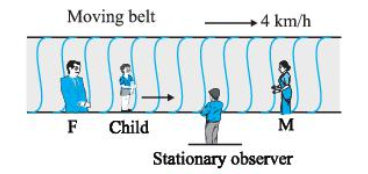On a long horizontally moving belt, a child runs to and fro with a speed 9kmh−1 ( with respect to the belt) between his father and mother located 50m a part on the moving belt. The belt moves with a speed of 4kmh−1. For an observer on a stationery platform outside, what is the
(i) speed of the child running in the direction of motion of the belt?
(ii) speed of the child running opposite to the direction of motion of the belt? (iii) time taken by child in (i) and (ii) ?
which of the answers alter if motion is viewed by one of the parents?

(a) Speed of the belt, vB = 4 km/h
Speed of the boy, vb = 9 km/h
Since the boy is running in the same direction of the motion of the belt, his speed (as observed by the stationary observer) can be obtained as:
vbB=vb+vB = 9 + 4 = 13 km/h
(b) Since the boy is running in the direction opposite to the direction of the motion of the belt, his speed (as observed by the stationary observer) can be obtained as:
vbB=vb+(–vB) = 9 – 4 = 5 km/h
(c) Distance between the child’s parents = 50 m
As both parents are standing on the moving belt, the speed of the child in either direction as observed by the parents will remain the same i.e., 9 km/h = 2.5 m/s.
Hence, the time taken by the child to move towards one of his parents is 502.5=20 s
(d) If the motion is viewed by any one of the parents, answers obtained in (a) and (b) get altered. This is because the child and his parents are standing on the same belt and hence, are equally affected by the motion of the belt. Therefore, for both parents (irrespective of the direction of motion) the speed of the child remains the same i.e., 9 km/h.
For this reason, it can be concluded that the time taken by the child to reach any one of his parents remains unaltered.
Topper's Solved these Questions
Similar Questions
A long belt is moving horizontally with a speed of 5 km/h. A child is running on belt to and fro with a speed of 9 km/h with respect to belt between his father and mother located 50 m apart on the belt. For an observer on a stationary platform outside, what is the
speed of the child running opposite to the direction of the belt ?
View SolutionA car covers the first half of the distance between two places at a speed of 40kmh−1 and second half at 60kmh−1 Calculate the average speed of the car.
View Solution
Knowledge Check
On a long horizontally moving belt, a child runs to an fro with a speed 9kmh−1 ( with respect to the belt) between his father and mother located 50m a part on the moving belt. The belt moves with a speed of 4 kmh−1. For an observer on a stationery platform outside, what is the
(i) speed of the child running in the direction of motion of the belt,
(ii) speed of the child running opposited to the direction of motion of the belt , and (iii) time taken by child in (i) and (ii) ?
which of the answers alter if motion is viewed by one of the parents?A4kmh−1,5kmh−1B5kmh−1,9kmh−1C9kmh−1,4kmh−1D13kmh−1,5kmh−1In the question number 97, the speed of the child running opposite to the direction of motion of the belt is
A4kmh−1B5kmh−1C9kmh−1D13kmh−1
A train moves with a speed o f30kmh−1 in the first 15 minutes,with another speed of 40kmh−1 the next 15 minutes,and then with a speed of 60kmh−1 in the last 30 minutes. Calculate the average speed of the train of train for this journey.
View SolutionA train is moving due East and a car is moving due North, both with the same speed 30kmh−1. What is the observed speed and diredction of motion of car to the passsenger in the train ?
View SolutionA 200 m long train moving with velocity 20ms−1 overtakes a man running in the same direction in 20 seconds. How long the train will take to overtake the man if he was running in opposite direction?
View SolutionA ship A is moving Westwards with a speed of 10kmh−1 and a ship B 100km South of A is moving northwards with a speed of 10kmh−1. The time after which the distance between them shortest is
View SolutionA train is running at a constant speed of 90 km/h on a straight track. A person standing at the top of a boggey moves in the direction of motion of the train such that he covers 1 meters on the train each second. The speed of the person with respect to ground to -
View SolutionThe driver of a car moving towards a rocket launching with a speed of 6 ms−1 observed that the rocket is moving with speed of 10 ms−1 The upward speed of the rocket as seen by the stationary observer is nearly
View Solution
